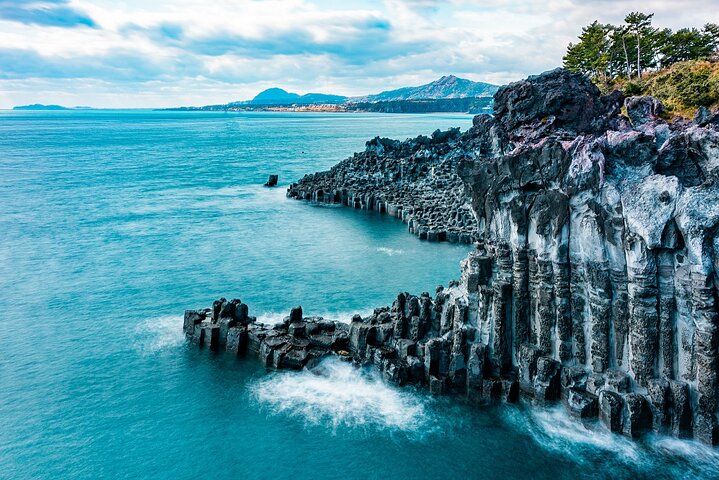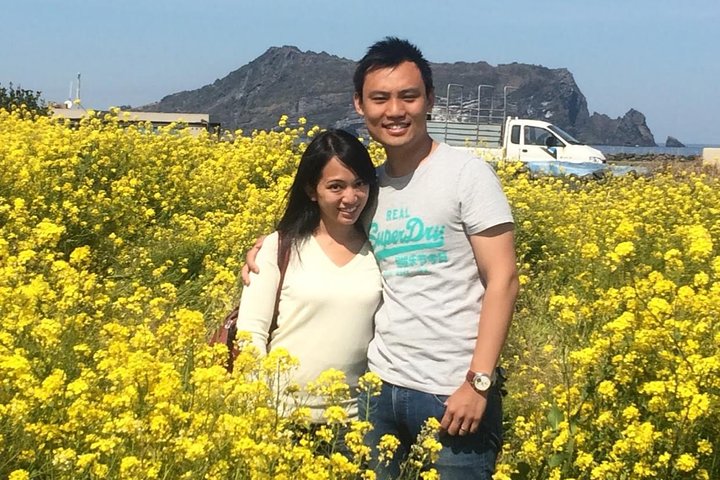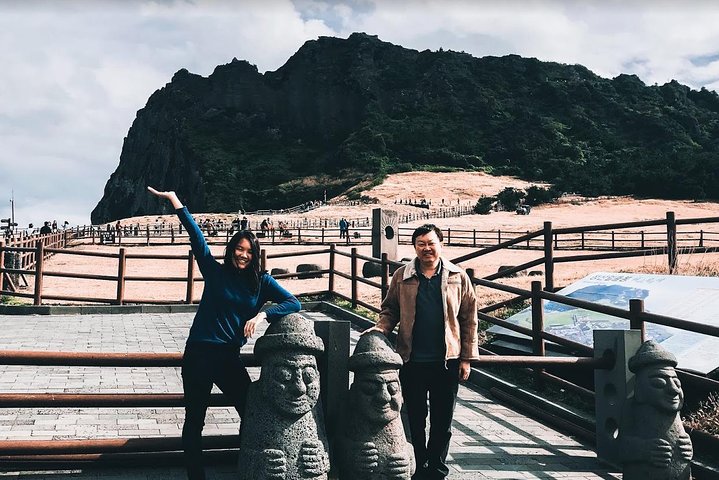Join Jeju Travel Lucas for an unforgettable UNESCO Heritage Bus Tour of Jeju Island. Explore the island’s culture and nature with no language barrier. Book now!
Join Jeju Travel Lucas for an unforgettable UNESCO Heritage Bus Tour of Jeju Island. Explore the island’s culture and nature with no language barrier. Book now!
Explore East Jeju UNESCO Heritage (Mon, Tue, Wed, Thu, Fri, Sat, Sun)
Saryeoni Forest Path - This forest trail is celebrated as one of Jeju’s top 31 hidden gems and is highly protected. It attracts tourists who love hiking and nature.
Seongeup Folk Village - This traditional village on Jeju Island has been preserved to reflect its historical…
Explore East Jeju UNESCO Heritage (Mon, Tue, Wed, Thu, Fri, Sat, Sun)
Saryeoni Forest Path - This forest trail is celebrated as one of Jeju’s top 31 hidden gems and is highly protected. It attracts tourists who love hiking and nature.
Seongeup Folk Village - This traditional village on Jeju Island has been preserved to reflect its historical state, with impressive stone piles designed to protect roofs from the wind. The buildings are considered important folk relics, as these castles and homes, built to thwart a Japanese invasion, have remained intact since the Joseon Dynasty.
Seopjikoji - Located at the eastern tip of Jeju Island, Seopjikoji offers breathtaking scenery, especially in April when yellow canola flowers bloom. “Seopji” is the area’s old name, and “Koji” is a Jeju dialect term for a sudden land bump.
Seopjikoji can be replaced with Sangumburi in October.
Seongsan Ilchulbong - This site is for photography tours only. No hiking is allowed, and entry requires a ticket. Enjoy a women divers’ show at 2:00 PM. Seongsan Ilchulbong, also known as ‘Sunrise Peak’, is a classic tuff cone formed by hydrovolcanic eruptions about 5,000 years ago. Located on Jeju Island’s eastern coast, it resembles a massive ancient castle. This tuff cone stands 182 meters high, with a preserved bowl-like crater and diverse inner structures from the sea cliff.
Jongdal-ri - The tour bus travels along the beautiful northeastern Jeju coastline, passing Hado Beach and Saehwa Beach en route to Manjang Cave. Jongdalri Shore Road is famous for its hydrangeas in summer.
Hamdeok Beach - On rainy days, Hamdeok Beach will be replaced by a visit to the Haenyeo Museum.
Manjang Cave [UNESCO World Heritage] is currently closed for anti-falling construction. It is set to reopen in August 2025. During this period, it will be replaced by ‘Hamdeok Beach’.
Haenyeo Museum - On rainy days, Jeju Stone Park will be replaced by a visit to the Haenyeo Museum.
The Jeju Haenyeo Museum was established to re-evaluate and preserve the haenyeo culture in Jeju, recording their significant social, economic, and historical contributions. The museum features informative exhibits about the local environment, fishing villages, folk culture, and the fisheries industry, with a focus on the unique haenyeo culture.
Sangumburi Crater - In autumn, the ridges of Sangumburi Crater turn golden with waves of silvergrass. Cedar trees dominate the eastern and western slopes, with Sawtooth oak in the surrounding area. Korean Fir has been planted to create a forest path. Excluding these lush forests, colonies of Eulalia grass cover large patches of the crater. The silvergrass colonies create the iconic scenery of Sangumburi Crater in autumn, a view cherished by visitors worldwide. Only in October instead of Seopjikoji. The best times to visit are October to December.
Manjanggul Cave - This is the world’s largest known lava tube formed by volcanic activity. Visitors can marvel at the landscape that resembles an underground world. The Stone Turtle, resembling Jeju Island, is particularly popular. If Manjanggul Lava Tube is closed (the first Wednesday of every month), the Jeju Haenyeo Museum will be the alternative tour course. Manjang Cave [UNESCO World Heritage] is currently closed for construction to prevent falling hazards. It is scheduled to reopen in August 2025. During this period, it will be substituted by ‘Hamdeok Beach’.
Discover Nature, Culture of Western Jeju (Mon, Tue, Wed, Thu, Fri, Sat, Sun)
Hallim-eup - Experience Haenyeo Diving: Female Divers in Jeju
Unique Cultural Tradition: Experience the centuries-old tradition of Jeju’s Haenyeo, recognized by UNESCO as Intangible Cultural Heritage.
Sustainable Fishing Practice: Witness the eco-friendly and sustainable harvesting methods of the Haenyeo.
Incredible Ocean Views: Enjoy the stunning views of Jeju’s clear waters and volcanic coastline.
Hands-on Learning: Try diving techniques, breath-holding skills, and harvesting sea life alongside experienced divers.
Connection with Nature: Experience the thrill and serenity of being in the ocean, directly connected to nature.
Unforgettable Memory: Create a unique and memorable experience that combines adventure, culture, and natural beauty.
O’sulloc Tea Museum - The Osulloc Tea Museum, located on Jeju Island, opened in 2001 as Korea’s first tea museum. In 2013, Osulloc Tea Stone was built next to the museum, offering visitors various tea experiences and cultural activity programs.
Sanbangsan Mountain - Sanbangsan, standing at 395 meters, is a typical dome-shaped, craterless volcano. Its name, Sanbang, comes from a natural stone cave in the mountain’s middle. Inside the cave, known as Sanbanggulsa Temple, there is a Buddha statue. According to legend, water drops from the cave ceiling are the tears of love shed by the goddess who protects Sanbangsan’s stone walls.
Yongmeori Coast - Yongmeori Coast is a volcanic beach formed by ash from violent explosions when hot magma met cold seawater. Descending the narrow path to the beach, visitors can also see a sandstone cliff. Its name, Yongmeori (meaning dragon’s head), comes from its resemblance to a dragon ready to dive into the sea. Entrance may be restricted during rising tides or bad weather. If Yongmeori Coast is closed, Mt. Songaksan will be the alternative tour course.
Cheonjeyeon Falls - Cheonjeyeon Falls, known as “The Pond of God,” consists of three sections. Around the falls, a variety of plant life thrives, including the rare ‘solimnan’ reeds. To the east, a cave releases cold water from the ceiling, creating the first waterfall. The water gathers into a pool and then falls twice more, forming the second and third waterfalls, which flow into the sea.
Daepo Haean Jusangjeolli Cliff - Jusangjeolli Cliff [UNESCO GEO Park] The columnar joints in the Jungmun Tourism Complex were designated as Natural Monument #433 on December 27, 2004. They resemble a large folding screen with black hexagon stone pillars. Visitors are mesmerized by the sight of the columnar joints with beautiful ocean waves crashing against them, showcasing nature’s greatness.
Songaksan Mountain - If Yongmeori Coast is closed (during rising tides or bad weather), Mt. Songaksan will be the alternative tour course.
The Ma Park - On rainy days, the Haenyeo Diving experience will be replaced by a visit to The Ma Park.
As the world’s first horse-themed park, Raon The Ma Park offers a permanent horse-riding performance, “Empire of Thousand Years. Oh! Goguryeo Dynasty,” based on the life of Jumong, the founder of the Goguryeo Dynasty. It also features high-quality horse-riding facilities for all skill levels. Visitors can enjoy various horse-related activities.

- Licensed Guide
- Entrance Fee
- Airport Drop-off Services
- In-Vehicle Air Conditioning
- Parking Fees/Fuel Fee
- Licensed Guide
- Entrance Fee
- Airport Drop-off Services
- In-Vehicle Air Conditioning
- Parking Fees/Fuel Fee
- Personal expenses
- Drinks and Meal
- Gratuities (recommended, not compulsory)
- Personal expenses
- Drinks and Meal
- Gratuities (recommended, not compulsory)
Jeju Travel Lucas ensures there is no language barrier, offering a wide range of activities on Jeju Island. Tours will not be canceled due to low attendance.
Monday to Sunday: Western Jeju [UNESCO]
Monday to Sunday: East Jeju [UNESCO]
Monday to Sunday: [K-DRAMA] East/West
Please see the itinerary below for UNESCO tours and refer to the main…
Jeju Travel Lucas ensures there is no language barrier, offering a wide range of activities on Jeju Island. Tours will not be canceled due to low attendance.
Monday to Sunday: Western Jeju [UNESCO]
Monday to Sunday: East Jeju [UNESCO]
Monday to Sunday: [K-DRAMA] East/West
Please see the itinerary below for UNESCO tours and refer to the main image for the UNESCO/K-Drama schedule.
Typically, our bus tours require a minimum of 13 participants to proceed, but we strive to avoid cancellations. Up to four people can enjoy the tour at the same rate with a regular taxi driver who has advanced English proficiency.
For groups of 5 to 10, we provide tours with a professional English-speaking guide (driver).
For groups exceeding 13, we will do our utmost to organize a tour with a professional English-speaking guide using a van (15 passengers), minibus (22 passengers), or bus (35 passengers). We look forward to welcoming more guests in the future.
- This tour/activity will have a Minimum of 2 travelers
- It will never be canceled just because there are fewer people.
- A regular taxi with an intermediate English-speaking driver for 3-4 people.
- 5-9 people in a minivan with an English-speaking guide(driver)
- 10+ people with a van and an English-speaking guide
- Experience Haenyeo Diving(This activity) could be canceled due to extreme weather or unforeseen events. If canceled, you may book a different date or ask for a refund.
- What to Bring(Experience Haenyeo Diving): Flip-flops, toiletries, towel, swimsuit (a change of underwear if you don’t have swimsuit)
For a full refund, cancel at least 24 hours before the scheduled departure time.
For a full refund, cancel at least 24 hours before the scheduled departure time.


















